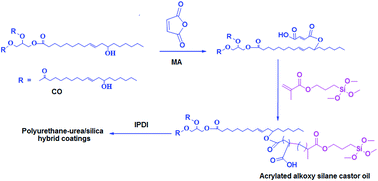Synthesis and characterization of castor oil based hybrid polymers and their polyurethane–urea/silica coatings
Abstract
Novel acrylated alkoxysilane castor oil (AASCO) with hydrolysable –Si–OCH3 was synthesized from castor oil, maleic anhydride and different weight percentages of 3-(trimethoxysilyl)propyl methacrylate (TMSPMA), via free radical copolymerization. The AASCO was characterized by 1H, 13C Nuclear Magnetic Resonance (NMR), Fourier transform infrared (FTIR) spectroscopy, gel permeation chromatography (GPC) and differential scanning calorimetry (DSC) techniques. This AASCO was further reacted with isophorone diisocyanate at NCO : OH ratio of 1.6 : 1 to get the isocyanate terminated silica hybrid polyurethane prepolymers. This work provides an effective and promising way to modify the castor oil backbone for high-performance coating application. The present work deals with the structural modifications of castor oil (CO), a renewable resource, to develop functional organic–inorganic hybrid polymers and their polyurethane–urea/silica (PU–urea/Si) coatings. For this purpose, a new acrylated alkoxysilane castor oil (AASCO) with hydrolysable –Si–OCH3 was synthesized from CO, maleic anhydride and different weight percentages of 3-(trimethoxysilyl)propyl methacrylate (TMSPMA), via free radical copolymerization. The AASCO was characterized by 1H, 13C Nuclear Magnetic Resonance (NMR), Fourier transform infrared (FTIR) spectroscopy, gel permeation chromatography (GPC) and differential scanning calorimetry (DSC) techniques. This AASCO was further reacted with isophorone diisocyanate at NCO : OH ratio of 1.6 : 1 to get the isocyanate terminated silica hybrid polyurethane prepolymers. The thermo-mechanical properties of the coating films were studied using Dynamic Mechanical Analysis (DMA), Thermogravimetric Analysis (TGA) and Universal Testing Machine (UTM). The coating films were evaluated for their salt spray resistance, swelling and contact angle (CA) properties. The CO modified silane based hybrid coatings have shown better mechanical, viscoelastic and CA properties when compared to control (CO based PU–urea) coatings. Similarly, the hybrid coating films with higher TMSPMA content have shown better thermal stability, less swelling and enhanced CA properties [water CA (102°), diiodomethane CA (72.75°)] and also exhibited excellent corrosion resistance properties.


 Please wait while we load your content...
Please wait while we load your content...